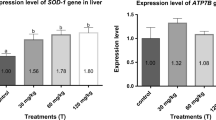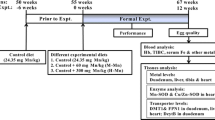Abstract
The experiment was conducted to investigate the effect of high dietary copper on catecholamine concentration and dopamine-β-hydroxylase (DβH) activity in hypothalami and midbrains of growing pigs. Forty-five crossbred weanling pigs with an average body weight of 7.5 kg were randomly assigned to three groups of 15 each to receive a control diet containing 10 mg/kg Cu (diet A) and diets containing 125 (diet B) or 250 (diet C) mg Cu/kg DM for 45 days. Compared to the control, Cu supplementation at both 125 and 250 mg Cu/kg DM increased average daily gain (ADG), average daily feed intake (ADFI), and feed efficiency. High dietary copper increased midbrain and hypothalami dopamine (DA) and norepinephrine (NE) concentrations and midbrain dopamine-β-hydroxylase activity. However, increasing dietary Cu had no effect on hypothalami dopamine-β-hydroxylase activity.
Similar content being viewed by others
References
Jondreville C, Revy PS, Dourmad JY (2003) Dietary means to better control the environ-mental impact of copper and zinc by pigs from weaning to slaughter. Livest Prod Sci 84:147–156
Braude R (1945) Some observations on the need for copper in the diet of fattening pigs. J Agric Sci 35:163–167
Burnell TW, Cromwell GL, Stahly TS (1988) Effects of dried whey and copper sulfate on the growth responses to organic acid in diets for weanling pigs. J Anim Sci 66:1100–1107
Cromwell GL, Stahly TS, Monegue HJ (1989) Effects of source and level of copper on performance and liver copper stores in weanling pigs. J Anim Sci 67:2996–3002
Cao J, Miao X, Xu W, et al (2014) Dietary copper requirements of juvenile large yellow croaker. Larimichthys croceus Aquaculture 432:346–350
Agga GE, Scott HM, Amachawadi RG, et al (2014) Effects of chlortetracycline and copper supplementation on antimicrobial resistance of fecal Escherichia coli from weaned pigs. Prev. Vet Med 114:231–246
Zhou W, Kornegay ET, Lindemann MD (1994) Stimulation of growth by intravenous injection of copper in weanling pigs. J Anim Sci 72:2395–2403
Yang W, Wang J, Liu L, et al (2011) Effect of high dietary copper on somatostatin and growth hormone-releasing hormone levels in the hypothalami of growing pigs. Biol Trace Elem Res 143:893–900
Li J, Yang L, Zheng X, et al (2008) Effect of high dietary copper on weight gain and neuropeptide Y level in the hypothalamus of pigs. J Trace Elem Med Biol 22:33–38
Edmonds CA, Izquierdo OA, Bark DH (1985) Feed additive study with newly weanling pigs: efficacy of supplement copper, antibiotics and organic acids. J Anim Sci 60:462–469
Prohaska JR, Bailey WR, Gross AM, et al (1990) Effects of dietary copper deficiency on the distribution of dopamine and norepinephrine in mice and rats. J Nutr Biochem 1:149–154
Gajewskaa A, Gajkowskab B, Pajakb B, et al (2009) Impaired growth hormone-releasing hormone neurons ultrastructure and peptide accumulation in the arcuate nucleus of mosaic mice with altered copper metabolism. Brain Res Bull 80:128–132
Fitzgerald PA (2011). Chapter 11. Adrenal medulla and paraganglia. In Gardner, D. G.; Shoback, D. Greenspan’s basic & clinical endocrinology (9th ed.). New York: McGraw-Hill. http://www.accessmedicine.com/content.aspx?aID=8404198. Retrieved October 26, 2011
Prohaska JR, Wells WW (1974) Copper deficiency in developing rat brain: a possible model for Menkes’steely-hair disease. J Neurochem 23:91–98
O’Dell BL, Smith RM, King RA (1976) Effects of copper status on brain neurotransmitter metabolism in the lamb. J Neurochem 26:451–455
Engle TE, Spears JW (2000) Dietary copper effects on lipid metabolism, perfor-mance, and ruminal fermentation in finishing steers. J Anim Sci 78:2452–2458
Strausak D, Mercer JF, Dieter HH, et al (2001) Copper in disorders with neurological symptoms: Alzheimer’s, Menkes, and Wilson diseases. Brain Res Bull 55:175–185
Joshua W. Pyatskowit, Prohaska Joseph R. (2007). Rodent brain and heart catecholamine levels are altered by different models of copper deficiency. Comp Biochem Physiol C, 145; 275-281
Zhou X, Espey MG, Chen JX, et al (2000) Inhibitory effects of nitric oxide and nitrosative stress on dopamine-betahydroxylase. J Biolumin Chemilumin 275:21241–21246
Gonzales-Eguis A, Chao-Ming F, Lu F-Y (2009) Effects of nanocopper on copper availability and nutrients digestibility, growth performance and serum traits of piglets. Livest Sci 126:122–129
Stahly TS, Cromwell GL, Monegue HJ (1980) Effects of the dietary inclusion of copper and (or) antibiotics on the performance of weanling pigs. J Anim Sci 51:1347–1351
Zhang W, Wang R, Kleemann DO, et al (2009) Effect of dietary copper on nutrient digestibility, growth performance and plasma cooper status in cashmere goats. Small Rumin Res 85:58–62
Yangen Z, Aleen Davis D, Rhodes MA (2014) Comparative evaluation of copper sulfate and tribasic copper chloride on growth performance and tissue response in pacific white shrimp Litopenaeus vannamei fed practical diets. Aquaculture 434:411–417
Armstrong TA, Cook DR, Ward MM, et al (2004) Effect of dietary copper source (cupric citrate and cupric sulfate) and concentration on growth performance and fecal copper excretion in weanling pigs. J Anim Sci 82:1234–1240
Zhang Q, Lin HR (1998) Influences of catecholaminergic drugs on growth hormone secretion to grasscarp fingerings. J Zhanjing Ocean Univ 818:35–38
Liu LL, Sun BS, Yang W (1998) Improved method to detect activity of dopamine β-hydroxylase in rat serum by ultraviolet fluorophotometer [J]. J Jilin Univ (Medicine Edition) 18:35–38
Acknowledgments
This study was supported by the national science and technology support program (grant no. 2012BAD39B03), the National Natural Science Foundation of China (grant no. 31302002), the National Science Foundation of Jilin Province of China (grant no. 20150101075JC), and the Jilin Provincial Department of Education project (grant no. 201252).
Author information
Authors and Affiliations
Corresponding author
Additional information
Wenyan Yang and Chunyu Zhao contributed equally to this study. Both are considered as first authors.
Rights and permissions
About this article
Cite this article
Yang, W., Zhao, C., Zhang, C. et al. High Dietary Copper Increases Catecholamine Concentrations in the Hypothalami and Midbrains of Growing Pigs. Biol Trace Elem Res 170, 115–118 (2016). https://doi.org/10.1007/s12011-015-0460-y
Received:
Accepted:
Published:
Issue Date:
DOI: https://doi.org/10.1007/s12011-015-0460-y




